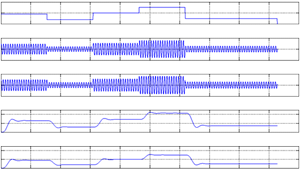Hartley’s amplitude, balanced and single band modulations
DOI:
https://doi.org/10.3103/S0735272722060036Keywords:
amplitude modulation, Hartley amplitude modulation, balanced modulation, Hartley balanced modulation, single sideband modulation, Hartley single sideband modulationAbstract
A new kind of modulation has been developed representing Hartley’s amplitude modulation (HAM) that differs from the amplitude modulation (AM) by the presence of two orthogonal components of amplitude-modulated signal making it possible to increase the HAM efficiency to 90% as compared to 33% for conventional AM at the maximum value of modulation index M = 1. The sum of signals of cosine and sine components is used as a signal of the carrier frequency that corresponds to function cas(a) = cos(a) + sin(a), which is applied as a kernel of the Hartley transform. Based on HAM, Hartley’s double band amplitude modulation, i.e., Hartley’s balanced modulation (HBM), and amplitude Hartley’s single sideband modulation (HSSB) were developed. It has been shown that HAM, HBM and HSSB modulations provide for the energy gain of 6 dB making it possible to double the range of communication as compared with the use of AM, balanced modulation (BM) and single sideband (SSB) modulation with the other conditions of signal transmission and reception being equal. While maintaining the specified range of communication at the fixed level, the transmitter power in case of using HAM, HBM and HSSB modulations can be reduced by a factor of 4 as compared with the case of AM, BM and SSB modulations, respectively. The application of HAM and HSSB modulations makes it possible to transmit narrow-band signals at considerable distances using the long, medium and short waves through ionospheric channels of communication with high efficiency, where the use of broad-band signals is difficult.
References
K. P. Jung, H. S. Son, J. H. Kim, C. S. Park, “Efficient 60-GHz power amplifier with adaptive AM-AM and AM-PM distortions compensation in 65-nm CMOS process,” IEEE Trans. Microw. Theory Tech., vol. 68, no. 7, pp. 3045–3055, 2020, doi: https://doi.org/10.1109/TMTT.2020.2985953.
A. Maskay, D. M. Hummels, M. P. da Cunha, “Separation of frequency and amplitude modulation contributions due to external vibration on a SAW resonator,” in 2018 IEEE International Ultrasonics Symposium (IUS), 2018, pp. 1–3, doi: https://doi.org/10.1109/ULTSYM.2018.8580151.
N. Jafar, A. Paeiz, A. Farzaneh, “Automatic modulation classification using modulation fingerprint extraction,” J. Syst. Eng. Electron., vol. 32, no. 4, pp. 799–810, 2021, doi: https://doi.org/10.23919/JSEE.2021.000069.
I. S. Gonorovskii, Radiotechnical Circuits and Signals. Textbook for Institutes of Higher Education, [in Russian]. Moscow: Sov. Radio, 1972.
C. Sun, T. Ji, H. Ji, Z. Xu, W. Shieh, “Experimental demonstration of complex-valued DSB signal field recovery via direct detection,” IEEE Photonics Technol. Lett., vol. 32, no. 10, pp. 585–588, 2020, doi: https://doi.org/10.1109/LPT.2020.2985590.
K. Choi, H. Liu, “Hilbert Transform, Analytic Signal, and SSB Modulation,” in Problem-Based Learning in Communication Systems Using Matlab and Simulink, Hoboken, NJ, USA: John Wiley & Sons, Inc., 2016, pp. 109–122.
G.-W. Lu, H.-B. Zhang, Z. Li, “Synthesis of SSB Nyquist 16QAM from twin-SSB QPSK via optical subcarrier processing-based data aggregation and its direct detection with hierarchical blind phase search algorithm,” IEEE J. Sel. Top. Quantum Electron., vol. 27, no. 2, pp. 1–8, 2021, doi: https://doi.org/10.1109/JSTQE.2020.2976542.
R. G. Lyons, Understanding Digital Signal Processing. London: Pearson, 2011, uri: https://www.pearson.com/us/higher-education/program/Lyons-Understanding-Digital-Signal-Processing-3rd-Edition/PGM202823.html.
A. B. Sergienko, Digital Processing of Signals, [in Russian]. St. Petersburg: Piter, 2003.
A. B. Kokhanov, S. V. Yemelianov, Y. V. Derevyagin, “Single sideband Hartley amplitude modulation,” Radioelectron. Commun. Syst., vol. 63, no. 11, pp. 574–585, 2020, doi: https://doi.org/10.3103/S0735272720110023.
J. G. Proakis, Digital Communications. McGraw-Hill, 1989.
Y. Zhu, M. Jiang, F. Zhang, “4Tb/s faster-than-Nyquist WDM 16-QAM signal transmission with Kramers-Kronig detection,” in 2018 Asia Communications and Photonics Conference (ACP), 2018, pp. 1–3, doi: https://doi.org/10.1109/ACP.2018.8595859.


